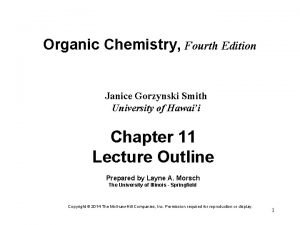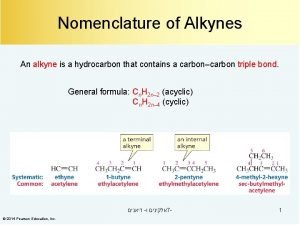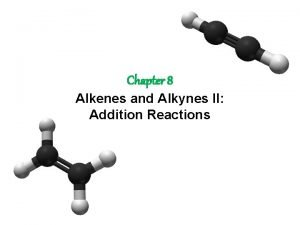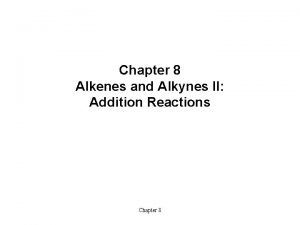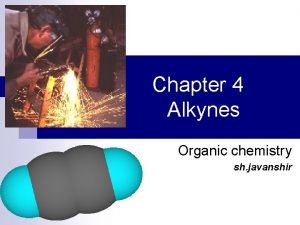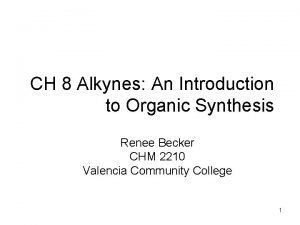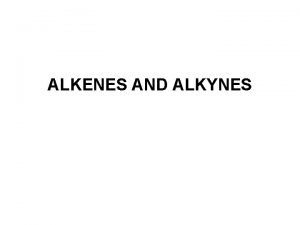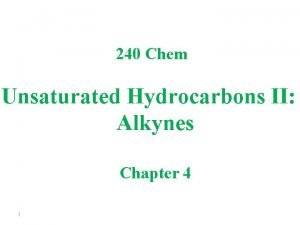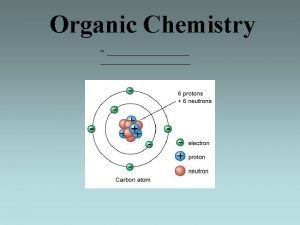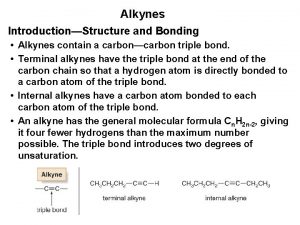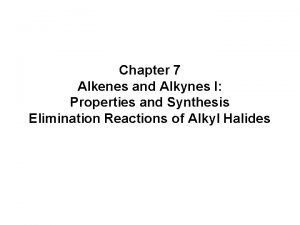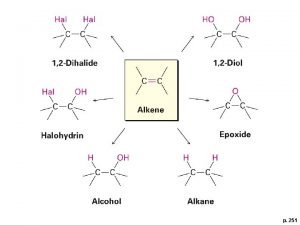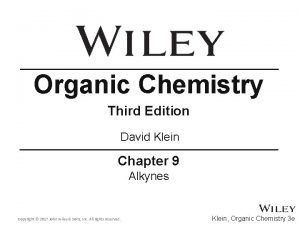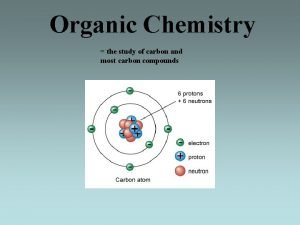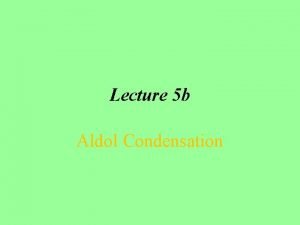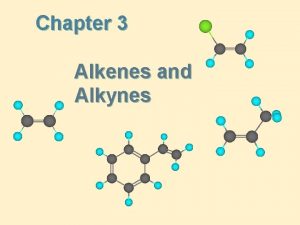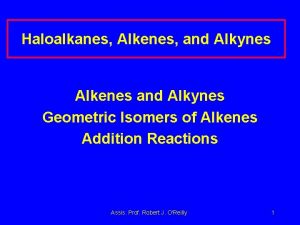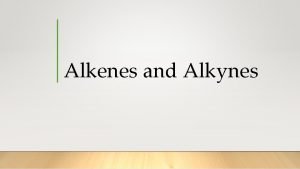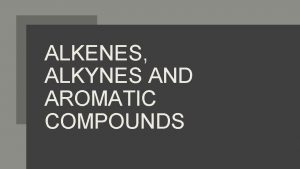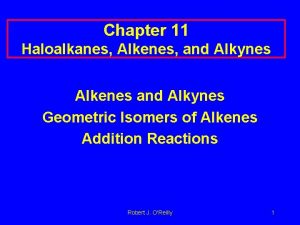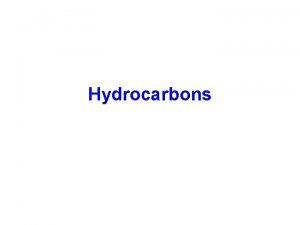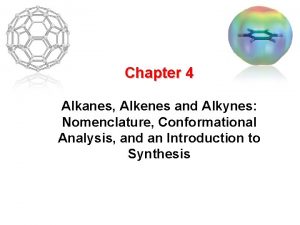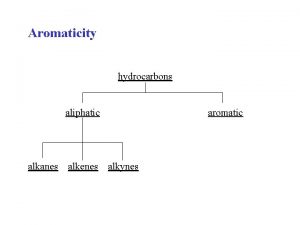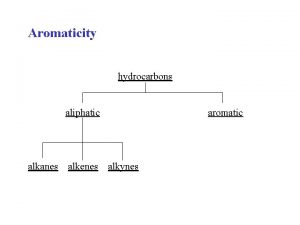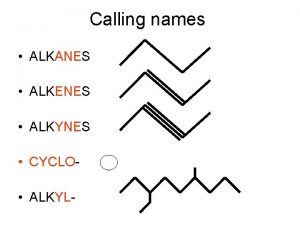Alkanes Alkenes Alkynes Straight chain alkanes will have
















- Slides: 16

Alkanes, Alkenes, Alkynes

• Straight chain alkanes will have symmetrical electronegativities so they will behave as nonpolar molecules • Since ‘like dissolves like’ the alkanes will all be soluble in eachother • However… since water is polar; alkanes will NOT dissolve in water… think of pouring oil on water.

Review Alkanes • Pattern: # of branch- (numerical prefix of branch amounts)( branch name) (parent name) If there are multiple branches: • start numbering the parent branch so that the closest branch has the smallest number • Name the branches in numerical and alphabetical order

Ways to represent hydrocarbon compounds: • Structural formula: include all hydrogen and carbons and their respective bonds • Condensed structural formula: Simplify the hydrogen attached to the carbons as such: CH 2 or CH 3 • Even simpler condensed structural formula: If there are long chains with say 6 - CH 2 in the chain they can be represented as (CH 2)6 • Mrs. Aitken’s shortcut: Only draw the carbons and use a line to represent bonds to hydrogen • Line structural formula: Use lines to represent the molecule, each corner is a carbon

• Draw: 2 -ethyl 4, 4 - dimethyl- hexane


• Examples

Hydrogenation • Hydrogenation is the addition of hydrogen to an alkene or an alkyne to produce • Example:

Natural Gas Refining • Natural gas is composed of several hydrocarbons but mostly methane • Raw Natural Gas is made of many impurities that make it “sour”. • It contains H 2 S(g) that has the “rotten-egg smell” and it can form acidic solutions with water.

• Refining –piped from well site to gas treatment plant 1. Water and hydrocarbons are removed. 2. chemically refined in absorber tower • it reacts with an amine such as ‘diethanolamine’ under high pressure and low temp to make it sweet removing the H 2 S(g) and CO 2(g) • H 2 S(g then reacts with O 2(g) and makes SO 2(g) • This is then sent to a recovery unit, Claus converter to get the sulfur out. H 2 S(g) + SO 2(g) S 8(s) + H 2 O(g) • Natural Gas can be 0 -80% hydrogen sulfide


• Now we have Sweet Gas… it has all of the components listed on p. 363 Table 1 • Most natural gas is further refined into these components but it could be burned at this point. • Fractional Distillation would be the process used to separate these components and then they can be used for the uses list on Table 2 on page 363.

Fractional Distillation • Natural gas is cooled under high pressure to condense all the components except the methane gas • The condensed liquid is then slowly distilled to separate out the different hydrocarbons

Ethane Cracking • Purpose: produce ethene from ethane • Ethane Cracking= Dehydrogenation • Ethane is one component of natural gas and can be used. • Cracking is an industrial process in which larger hydrocarbon molecules are broken down at high temperatures with or without catalysts to produce smaller hydrocarbon molecules.

• Cracking usually refers to breaking a large molecules down into a smaller molecule. • Ethane is ‘cracked’ or dehydrogenated by adding heat and the products are: ethene and hydrogen • Example:

• Pg. 377 #1 -5 • Pg. 380 #6, 7, 11
 Alkanes alkenes alkynes
Alkanes alkenes alkynes Food chain food chain food chain
Food chain food chain food chain Halogenation of alkynes
Halogenation of alkynes Triple bond nomenclature
Triple bond nomenclature 2 methylpropene + hbr
2 methylpropene + hbr Addition of hydrogen halides to alkynes
Addition of hydrogen halides to alkynes Mercury catalyzed hydration of alkynes
Mercury catalyzed hydration of alkynes Mercury catalyzed hydration of alkynes
Mercury catalyzed hydration of alkynes General formula for alkenes
General formula for alkenes Ozonolysis of alkynes
Ozonolysis of alkynes Alkynes structural formula
Alkynes structural formula Preparation of alkynes
Preparation of alkynes Alkynes
Alkynes Dihydroxylation
Dihydroxylation Hydroboration of alkynes
Hydroboration of alkynes First 10 members of alkynes
First 10 members of alkynes Filter plates for aqueous filtration
Filter plates for aqueous filtration


